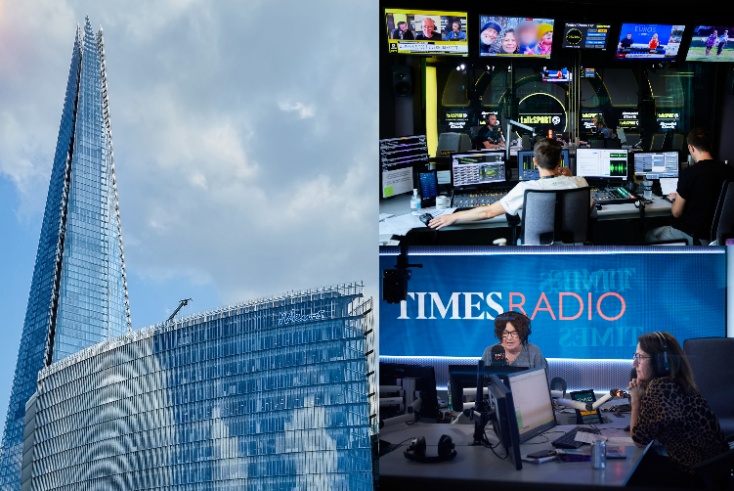News UK: Video and multi-channel talent loom large for radio

Feature: 50 Years of Commercial Radio
News Broadcasting’s head of audio and commercial director share the biggest changes they have seen in commercial radio and what’s next.
“Radio can be more glamourous than it has ever been if it puts its mind to it.”
This is what Dennie Morris, director of audio at News Broadcasting, tells The Media Leader when speaking about what the next 50 years of commercial radio has in store.
“There is a romance around radio, but we have got to keep adapting,” Morris says, and this applies not just to his company’s audio content and advertising, but the whole radio industry in order to “be able to grow”.

For Morris (pictured, left), one example of radio adapting is introducing cameras and “visualisation” to News Broadcasting’s studios. There are cameras in every studio, which are used to create teaser videos across social media.
“The one-on-one connection does not go away when you turn on a camera. It can be even more powerful,” Morris emphasises, adding radio presenters are “the best presenters” to connect to a single person consuming their content compared to other types of presenters.
Audio will always be “powerful”, and a camera will not diminish that, Morris stressed, adding: “Radio advertising can be more powerful than TV advertising. The one-on-one connection skill with visuals.”
Avoiding ‘knee-jerk’
Collaborating and cross-pollinating content is also “a big priority” for News Broadcasting this year with new daily group editorial meetings attended by representatives from all of the stations, with editors from The Sun and The Times also in attendance, to discuss how they can share their content. The day The Media Leader visited the studios coincided with the England Women football team reaching the World Cup Final for the first time; in real-time one could see how content from TalkSport was keenly being demanded from other News UK brands.
Morris notes it is important to “constantly monitor” and “take learnings” from the growth in connected and smart speaker listening but not have “knee-jerk reactions”. He warns that they need to think about the user experience and make it easier to listen on every single device. This also applies to audio advertising; while he insists this is “very healthy”, Morris says that ads must adapt to how audiences consume content.
He also says it is important to not forget about creativity, explaining that music and news radio can be “quite programmed”, and it “would be great” to go back to a time with “more fun moments” and creativity.
“We have to keep innovating and that’s what creative industries do,” Morris concludes.
Radio is more than a station — it is a media brand and digital product
 David Wilcox (pictured, right), commercial director of News Broadcasting, tells The Media Leader that a major change he has seen was that the division is now working much more with “media brands”, because of the cross-pollination of content and the growing digital distribution platform.
David Wilcox (pictured, right), commercial director of News Broadcasting, tells The Media Leader that a major change he has seen was that the division is now working much more with “media brands”, because of the cross-pollination of content and the growing digital distribution platform.
“It’s not just radio. TalkSport is probably the furthest along this particular path in that it is actually a sports media brand as opposed to a radio station. We’ve got broadcast quality video-on-demand on our owned-and-operated channels, and on Facebook and YouTube, which seems to be really attractive to advertisers,” he explains.
Wilcox adds: “Video and multi-channel personalities are very much where we want to push these brands and each individual area will develop over time. Podcasts and the nature of podcasts will develop over time. The snackable clips from the studio may change over time. You have got to be open to that adaptation to survive, and don’t forget you’ve got to make content that people are interested in consuming above all else.”
Wilcox describes radio as “much more dynamic” compared to his previous experience in newspapers, and “constantly evolving and developing and exciting to be around”. Are advertisers fully on board with radio’s ongoing evolution?
Radio can still get “pigeonholed” as a “complimentary” channel on media plans, Wilcox says, but it does do this job “extremely well”.
However, he adds: “I don’t think radio is underappreciated because the things you can do with radio are so vast and the possibilities pretty much endless of what we can do for advertisers, within the rules of course. Sometimes it will be put on plans without thinking what is potentially achievable, and it’s its own channel. Buying a spot is probably a very simple and effective way of marketing but you can supercharge your marketing messages by thinking a bit harder about it.”
While the potential roles played by radio on a media plan have changed, it seems its perception has not moved as far as it should have done.
Wilcox says: “That’s probably one of our biggest challenges [how radio is perceived on a media plan]. People still think of it in terms of radio, but it could be VOD, it could be data-targeted digital in-stream, it could be podcasts. There’s all these different ways that you can use the medium and its associated products, as opposed to what was historically just a spot ad on a radio station.”
He has noticed over the last 18 months how partnerships are now moving beyond spot ads or live-reads, now including homepage takeovers, pre-roll branded content, podcasts and more which clients and agencies seem to like.
Another example of radio being more than a linear spot ad is Octave, News UK’s joint venture with Bauer Media, which was launched in 2020. Wilcox says it shows a “frightening” pace of acceleration after starting with six target segments for digital audio powered by both media owners’ first-party data. “Who would have thought 20 years ago radio would be in that space?” wonders Wilcox.
Echoing Morris, Wilcox remarks: “Radio is still reaching 88% of people through live radio, and that’s before you think of catch-up or listen again and pods people might be tuning into. I think all great media adapts over time and hopefully, radio as an industry, particularly commercial radio, is very good at doing that.”
News Broadcasting houses national radio stations TalkSport, Virgin Radio UK (through acquisition of Wireless Group in 2017), TalkRadio and Times Radio. The radio stations moved into the News UK building by the Shard in 2018 and their floor has impressive views overlooking the Thames.
In the latest Rajar results, News Broadcasting reported its highest ever listening hours, up 16% year-on-year to 44.1 million, with 84% of these coming from digital sources (including DAB), and 35% from streaming, the highest of any broadcasting group in the UK.
This is part of The Media Leader‘s series to commemorate commercial radio’s 50th anniversary. You can find the other articles in the series here.




